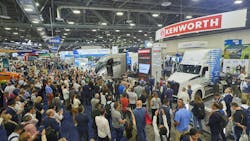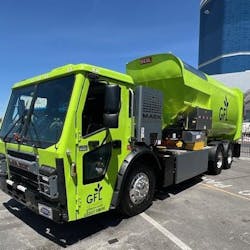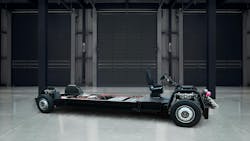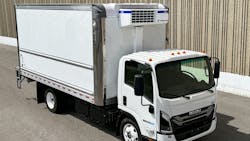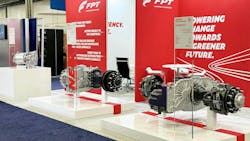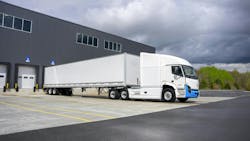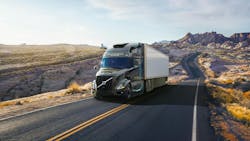This Week in Power & Motion: ACT Expo Highlights the Latest in Electrification Technologies
There is much going on in the world of hydraulic, pneumatic and electric motion systems, from technology introductions and industry advancements to new trends and industry leaders. Each week the Power & Motion team collects the latest industry news to help keep our readers up to date on what's happening in the fluid power and electric motion control sectors as well as the industries they serve.
For this week's edition, we are recapping news coming out of the Advanced Clean Transportation (ACT) Expo — an annual event focused on technologies, services, and vehicles enabling a low- and zero-emission transportation industry. The show brings together fleet operators, vehicle OEMs, technology developers, utilities and other entitities involved in the transportation sector.
For even more news from ACT Expo 2024, check out these pieces from other Endeavor Business Media partner sites.
Construction Equipment
Volvo CE Launches Two Mobile Chargers
FleetOwner
Bendix showcases global scalable air treatment, electric air compressors at ACT Expo
New Penske venture wants to help fleets with charging infrastructure
Volvo Trucks launches On Demand EV adoption service
Report: How is clean vehicle technology adoption doing among fleets?
There has been a lot of activity in recent years to reduce emissions from heavy-duty trucks and other vehicles which move goods through electrification, use of alternatives to diesel fuel and other technologies. These efforts will continue to grow as the global population becomes more concerned with sustainability and reducing carbon emissions.
With these technological changes are coming changes to the fluid power and electric motion control systems used in the transportation sector, making ACT Expo a show to watch for many of Power & Motion's readers. Danfoss, The Lee Company, HED Inc., Parker Hannifin, Schaeffler, and other relevant motion control developers exhibited at the show which again demonstrates its significance to our industry and the various markets it serves.
ACT Expo 2024, which took place May 20-23, is expected to be the largest yet with close to 500 exhibitors and record-breaking attendance anticipated, further demonstrating the growing interest in clean transportation technologies. Following are news highlights from this year's event.
Mack Electric Refuse Truck Available with Electric Side Loader
Mack Trucks announced the Heil fully electric RevAMP Automated Side Loader (ASL) will be an available option with its Mack LR Electric Class 8 battery-electric refuse vehicle. The ASL is a compactor and auger which does not include hydraulics, preventing potential leaks or breaks and reducing maintenance needs.
Instead, the ASL features a lift arm capable of providing fast and precise motion which is shake free to ensure comfort for vehicle operators. It has an independent battery pack as well to help minimize power drain from the LR Electric's battery, enabling longer run times. In addition, the auger is more compact which requires less energy and again reduces battery energy use.
As the LR Electric typically includes hydraulics for the compactor, an ePTO (electric power take-off) is included to for transmitting power from the batteries to the hydraulic system. However, for those vehicles equipped with the ASL the ePTO is removed. The truck's center of gravity also has to be adjusted to accommodate the dense packing capabilities of the auger system.
READ MORE: Revenue Potential Increasing for Electric Truck Powertrain Components
REE Introduces New Software-Driven Electric Vehicle Chassis
Technology company REE Automotive introduced its P7-S stripped chassis created in collaboration with a delivery fleet customer. It is a software-driven chassis which incorporates the company's REEcorner by-wire steering technology.
By offering a stripped down chassis, the P7-S provides customers the ability to customize it to their specific electric vehicle needs. Driver position, battery placement, wheelbase and rear overhang are all aspects which can be chosen by customers for their Class 4-5 vehicles.
Incorporation of the REEcorner — which are modular in design to allow for chassis customization — and software-driven design enables shared services and spare parts with other REE technologies, easing maintenance for customers. Vehicles are becoming more software defined, bringing opportunities to rethink system architectures while offering greater control and insights into performance. This also allows for easier updating of software so the latest features or perfomance updates can be added.
"Based on our flagship P7 REEcorners, we can proliferate in a rapid and cost-effective manner our modular offering, while creating exactly what the fleets want rather than taking a ‘one size fits all’ approach," said Daniel Barel, CEO and co-founder of REE Automotive. "REE is working with the fleets or OEMs to bring to market a vehicle quickly and with minimal CapEx investment, and solidifying this through validation from a leading delivery fleet is a testament to our go-to-market strategy."
Isuzu Develops Electric Truck with Electric Refrigerated Body
Isuzu Commercial Truck of America, Inc. has developed an all-electric truck integrated with a Thermo King e300 all-electric transport refrigeration unit (TRU). The company plans to begin production of the new NRR EV Class 5 medium-duty truck in the summer of 2024.
The truck's powertrain can be equippedwith one of four battery pack configurations offering estimated ranges from 60-235 mi. A key component of the powertrain is the ePTO with an operating range from 7-12 kWh and peak output of 26 kWH for demand spikes. It is designed to work without a switch, eliminating the need for drivers to dial it up or down to meet power demands of onboard equipment. Instead, an onboard computer system communicates directly with the Thermo King all-electric refrigeration unit to provide the required power.
Thermo King's electric refrigeration unit is designed to fully integrate into the chassis of an OEM's electric vehicle with minimal impact on range. It features an electric reciprocating compressor for continuous system capacity which is not susceptible to engine speed changes as engine-driven systems often are.
Traditional components such as the belt-driven compressor, mount and drive kit, and refrigeration hose are eliminated with the electric refrigeration unit, helping to reduce installation time and maintenance as there are fewer wear parts.
FPT Showcases Next Generation eAxles
Powertrain manufacturer FPT Industrial exhibited several of its ePowertrain solutions, including its second generation eAxles.
On display at ACT Expo was the 6x4 eAX375 electric axle (eAxle), which is new to the North American market and one of the first models available from the company's next generation of eAxles. It features multi-speed gearing and adaptability to different electric vehicle powertrain requirements. The axle is designed to provide up to 30,000 Nm (22,000 lb.-ft.) torque at the wheels, and service life of up to 1 million miles (depending on customer applications).
Also on display was the eAX840-R single-speed dual-motor electric axle initially developed in collaboration with Nikola, a developer of battery-electric and hydrogen powered trucks. The axle is designed for heavy vehicles. Its single-speed design eliminates the need for a transmission control unit, enabling a simplified system and reduced development time.
FPT showed its eCD140 central drive as well which allows an electric drive system to be integrated into existing conventional vehicles up to 8 tonnes GVW (gross vehicle weight). The central drive is designed for easy integration into existing vehicle platforms and requires minimal space.
Axles and other powertrain components have traditionally used hydraulics and pneumatics, but with the shift to electrification there is a move away from these fluid power technologies; in some cases a combination of fluid power and electric technologies are used for electric vehicle powertrain components.
Lion Electric Unveils All-Electric Class 8 Truck
The Lion Electric Company, a manufacturer of electric vehicles, debuted its Lion8 Tractor at ACT Expo 2024. It is an all-electric Class 8 commercial truck with a gross combination weight rating (GCWR) of 127,000 lbs.
Lion's heavy-duty battery packs with capacity up to 630 kWh are used to power the truck, giving it a range of up to 275 mi. (440 km). A 6x4 axle configuration with two integrated 2-speed eAxles is available on the Lion8 for optimized maneuverability and efficiency.
The truck includes several intelligent features as well to aid performance and safety including Vehicle-to-Grid (V2G) compatibility, Advanced Driver Assistance Systems (ADAS) and an onboard weighing system.
Charging is often a concern with larger electric vehicles. Lion states its electric Class 8 truck can reach an 80% state of charge at maximum power in about 1.5 hours to reduce downtime for drivers.
Volvo Debuts Production Ready Autonomous Truck
Volvo Autonomous Solutions, part of the Volvo Group, introduced its production ready autonomous truck. The Volvo VNL Autonomous is purpose designed and bulit for autonomy and uses autonomous driving technology from Aurora Innovation.
Redundant steering, braking, communication, computation, power management, energy storage and vehicle motion management systems are integrated into the truck to ensure safe operation. "We built the Volvo VNL Autonomous from the ground up, integrating these redundancy systems to ensure that every safety-critical component is intentionally duplicated, thereby significantly enhancing both safety and reliability," said Shahrukh Kazmi, Chief Product Officer at Volvo Autonomous Solutions.
Volvo worked closely together with Aurora to integrate the latter's SAE Level 4 autonomous driving system into the VNL. The system uses artificial intelligence (AI) software, dual computers, and a range of sensors including proprietary lidar, imaging radar, high-resolution cameras and more for safe navigation.
Autonomy is seen as a way to help improve productivity which can aid with emissions reduction efforts as a vehicle can often be operated more efficiently (i.e., use less energy) when there is less human interaction required.
Volvo Autonomous Solutions plans to assemble the VNL Autonomous at Volvo's New River Valley plant in Dublin, VA.
About the Author
Sara Jensen
Executive Editor, Power & Motion
Sara Jensen is executive editor of Power & Motion, directing expanded coverage into the modern fluid power space, as well as mechatronic and smart technologies. She has over 15 years of publishing experience. Prior to Power & Motion she spent 11 years with a trade publication for engineers of heavy-duty equipment, the last 3 of which were as the editor and brand lead. Over the course of her time in the B2B industry, Sara has gained an extensive knowledge of various heavy-duty equipment industries — including construction, agriculture, mining and on-road trucks —along with the systems and market trends which impact them such as fluid power and electronic motion control technologies.
You can follow Sara and Power & Motion via the following social media handles:
X (formerly Twitter): @TechnlgyEditor and @PowerMotionTech
LinkedIn: @SaraJensen and @Power&Motion
Facebook: @PowerMotionTech
